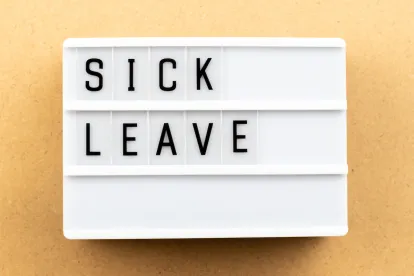The California Department of Industrial Relations (DIR) recently released new guidance clarifying how employers using mandatory paid sick leave accrual and caps may transition to the increased amount of forty hours or five days of mandatory paid sick leave that go into effect on January 1, 2024.
Quick Hits
- California’s amended paid sick leave law will require employers to provide employees at least forty hours or five days of paid sick leave per year beginning January 1, 2024.
- New guidance from DIR clarifies that employers that use a sick leave accrual method may need to adjust the accrual beginning January 1, 2024, to comply with the new forty-hour or five-day minimum.
- Employers that frontload paid sick leave may need to provide additional frontloaded sick leave on January 1, 2024.
On December 12, 2023, DIR published a set of frequently asked questions (FAQs) on amendments to California’s Paid Sick Leave Law made through legislation, Senate Bill (SB) 616, signed by Governor Gavin Newsom in October 2023.
SB 616, which amended the Healthy Workplaces, Healthy Families Act of 2014, will increase mandatory paid sick leave to a minimum of forty hours or five days per year from twenty-four hours or three days. Employers may continue to either frontload or accrue the sick pay. Employers that accrue sick pay may cap accrual at eighty hours or ten days, and may cap annual use at forty hours or five days.
The new paid sick leave requirements take effect on January 1, 2024. Here is a breakdown of some of the key points from the FAQs.
Mandatory Paid Sick Leave Increase
Under the new amendments, beginning January 1, 2024, employers must provide employees with at least forty hours or five days of paid sick leave per year, increasing the required leave amount from twenty-four hours or three days.
The law provides for forty hours or five days, whichever is more. The guidance clarifies that this means if an employee works ten-hour days, that employee will be entitled to use a minimum of fifty hours of paid sick leave, but an employee who only works six-hour days for a total of only thirty hours will still be entitled to the remaining ten hours of leave.
Accrual or Frontloading of Paid Sick Leave
The FAQs confirm that employers have the option of either allowing employees to “accrue” paid sick leave or providing the sick leave “up front.”
- Accrual Method
Employers may accrue sick pay on an hourly basis as long as the accrual rate is at least one hour per thirty hours worked. While employers may adopt an accrual schedule other than one in which employees accrue one hour of sick leave for every thirty hours worked, DIR stated that “the schedule must result in an employee having at least 24 hours of accrued sick leave or paid time off by the 120th calendar day of employment and 40 hours by the 200th calendar day of employment.”
- Up-front Method
When employers provide sick leave up front, new hires need not receive sick pay immediately upon hire. New hires must receive forty hours sick pay available for use by the 120th day of employment. As to current employees, the FAQs clarify that employees will be entitled to at least forty hours or five days of paid sick leave per year and that the full amount must be made available for the employee’s use “from the beginning of each year of employment, calendar year, or 12-period.”
Transitioning to New Paid Sick Leave Requirements
The FAQs provide some specific guidance for how employers using accrual or up-front methods may transition to the new increased mandatory paid sick leave:
- “If an employer uses an accrual method and capped an employee’s yearly use of leave at 3 days or 24 hours, what must an employer do to comply with the law on January 1, 2024?”





 />i
/>i
